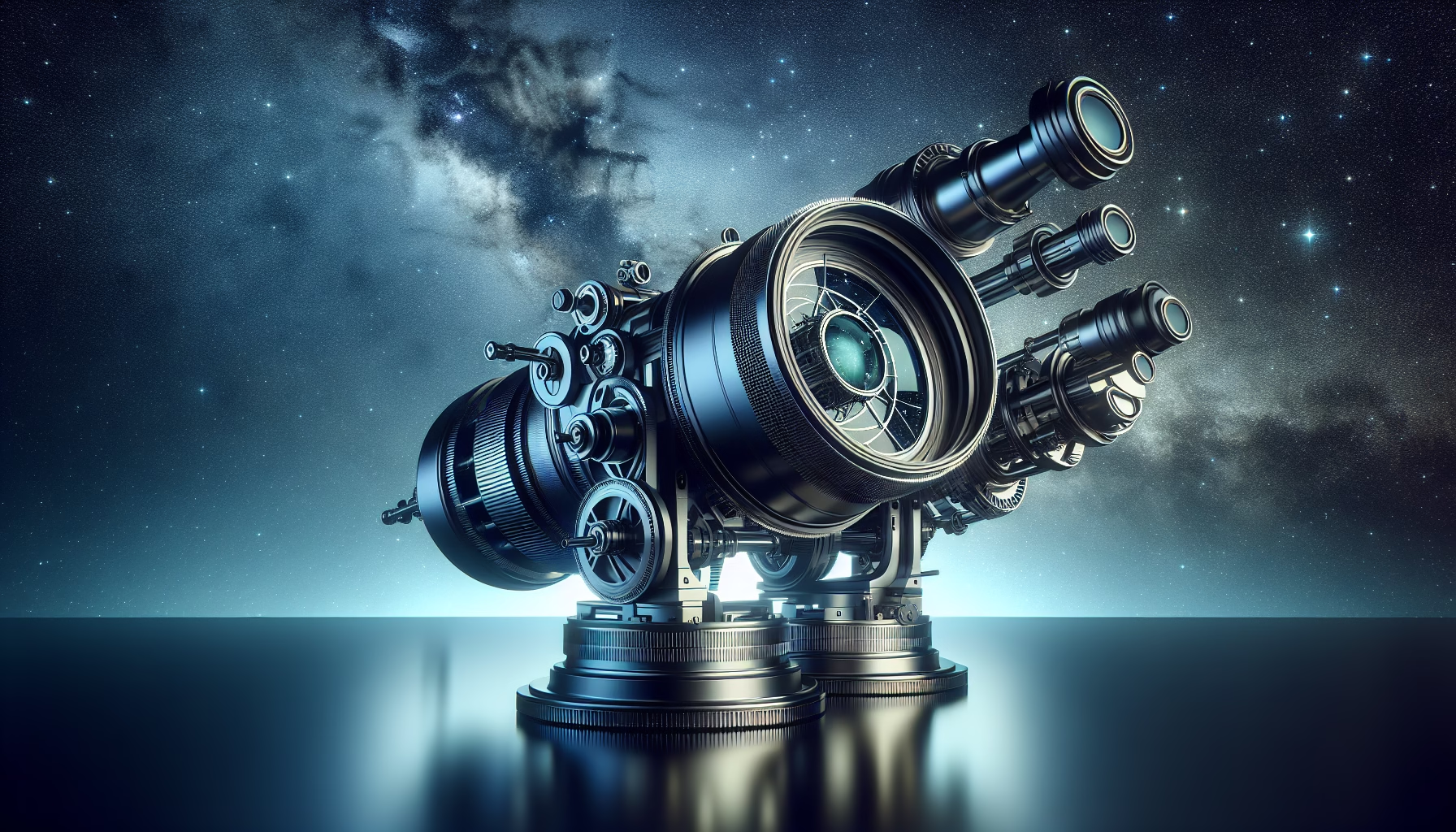Have you ever wondered how telescope innovations have shaped today’s world and what doors they might open in the future? The evolution of telescopes, from their inception to their current sophisticated design, represents a journey of scientific curiosity and technological advancement. This article delves into the historical and contemporary development of telescopes, analyzing their impact on both scientific discovery and everyday life.

Table of Contents
Understanding the Genesis of Telescope Innovation
The Birth and Evolution of Telescopes
The telescope, as we know it, originated in the early 17th century. Early constructs primarily focused on magnification and were simple in design. They laid the groundwork for future technological advancements. Over time, incremental improvements led to a significant impact on astronomy and contributed to expanded knowledge of the universe.
Hans Lippershey, a spectacle maker in the Netherlands, is credited with creating the first practical telescope in 1608. By allowing distant objects to appear closer and clearer, his invention captivated the imaginations of scientists like Galileo Galilei, who significantly improved upon its design. Galileo’s refinement of the telescope in 1609 marked the beginning of revolutionary astronomical discoveries, as he became the first to observe Jupiter’s moons and the phases of Venus.
Historical Milestones in Telescope Development
Several pivotal moments in the history of telescope innovation have altered our view of the universe. Following Galileo, Sir Isaac Newton developed the first reflecting telescope in 1668. This design utilized mirrors rather than lenses, reducing chromatic aberration and allowing for more powerful and accurate observation.
The 20th century saw the creation of larger telescopes with improved optics and scientific instruments. The Hubble Space Telescope, launched in 1990, allows scientists to peer deep into space with unprecedented clarity, leading to groundbreaking discoveries about the universe’s expansion and the nature of dark matter and dark energy.
Contemporary Telescope Technologies
Advances in Optics and Imaging
Modern telescopes are the result of continuous technological innovation characterized by improvements in optics and imaging capabilities. Adaptive optics systems and laser guide stars have enabled ground-based telescopes to correct atmospheric distortions, providing clearer images. Space telescopes, free from Earth’s atmospheric interference, deliver exceptionally precise images of distant celestial bodies.
The integration of digital sensors with telescopic imaging has opened new horizons, enabling the capture of images in various spectrums of light, including ultraviolet and infrared. These instruments allow scientists to study astronomical phenomena invisible to the naked eye and even traditional telescopes.
Cutting-Edge Materials and Design
Material science has played a pivotal role in the recent enhancement of telescopic instruments. Lightweight, durable materials help create large mirrors and lenses necessary for capturing faint light from distant galaxies. For instance, beryllium and silicon carbide are employed in the construction of mirrors in space telescopes due to their favorable thermal properties.
Innovative design approaches, such as segmented mirror telescopes, allow for building large apertures without the logistic challenges associated with single-piece mirrors. These advancements enable deeper and more detailed examinations of the universe, contributing to scientific knowledge and understanding.

The Scientific Impact of Modern Telescopes
Expanding Our Understanding of the Universe
Modern telescopes have dramatically expanded our understanding of astronomical phenomena. Through telescopic advancements, scientists have discovered exoplanets within the habitable zone of distant stars, observed the cosmic microwave background radiation, and gained insights into black holes and the lifecycle of galaxies.
Time-series data, derived from continuous observation, provide invaluable insights into cosmic events, such as supernovae and planetary transits. The data gathered help refine astronomical models, enhancing our understanding of celestial mechanics and the evolution of the universe.
Contributions to Other Scientific Fields
Beyond astronomy, telescope innovations have permeated other scientific fields. For instance, spectroscopic analysis in telescopic research has applications in materials science and environmental studies. Techniques developed for astro-photonic technologies have contributed to telecommunications and optical computing, demonstrating the cross-disciplinary impact of telescope advances.
Medical imaging has also benefited from optical innovations initially developed for astronomical telescopes, illustrating a broader societal impact that extends well beyond space observation.
Broader Societal Impacts of Telescope Innovations
Influencing Technology and Industry
The technological innovations spurred by telescope development influence numerous industries. Precision optics and imaging technologies are integral to sectors such as pharmaceuticals, defense, and telecommunications. The drive for clarity and detail in telescopic instruments has led to advancements in lenses, sensor technology, and imaging processing utilized across diverse commercial applications.
Moreover, telescope-driven advancements in control systems and data processing are integral to the development of sophisticated instrumentation required in modern factories and laboratories.
Educational and Cultural Influences
On an educational front, telescopes serve as powerful tools for learning and inspiration. They capture the imagination of students and educators alike, urging them to explore the vastness of space. Planetariums and public observatories often rely on telescopes to engage audiences with the wonders of the cosmos, sparking interest in science and technology among new generations.
Culturally, telescopes deepen our understanding of humanity’s place in the universe, broadening perspectives and encouraging philosophical contemplation about existence and the nature of life beyond our planet.

Perspectives on the Future of Telescope Technology
Anticipating Technological Developments
What does the future hold for telescope technology? Research and development are continuously underway, with projects like the James Webb Space Telescope and the European Extremely Large Telescope set to push the boundaries of our cosmic exploration. These advancements promise detailed views of distant celestial phenomena previously beyond our reach.
Future telescopes will likely continue to capitalize on evolving technologies in optics, data processing, and material science. Anticipating developments in artificial intelligence and machine learning may also enhance data analysis, providing more profound insights into the universe’s mysteries.
Potential Challenges and Considerations
However, these advancements are not without potential challenges. The escalating cost of cutting-edge telescope projects, alongside the technical hurdles of operating complex instrumentation, poses significant considerations for the scientific community. Moreover, the increasing volume of data generated necessitates improved data storage and analysis infrastructures.
Environmental concerns also come into play, especially with large telescopes requiring significant land usage and potentially impacting ecological regions. Addressing these challenges involves balancing scientific advancement with financial, technical, and environmental considerations, fostering sustainable developments in telescope technologies.
Practical Applications and Utilization
How to Harness Information from Telescopic Discoveries
Additionally, the practical applications of information gleaned from telescopic discoveries extend to enhancing predictive models for weather patterns, climate change, and even disaster management. By understanding cosmic phenomena and models governing planetary systems, scientists can improve Earth-based forecasting technologies.
Data-driven insights from telescopic research can also refine models used in navigation systems, contributing to more accurate satellite and GPS technologies. By leveraging this information, industries can optimize operations, ensuring productivity and efficiency in a globally interconnected economy.
Engaging with and Contributing to Ongoing Developments
Individuals interested in telescopic advancements can engage through amateur astronomy clubs and open-source research initiatives. Public engagements, citizen science projects, and collaborative platforms democratize access to astronomical data, fostering wider participation and contribution to the field.
Understanding and participating in the discourse around telescope innovation enables individuals and communities to contribute to ongoing advancements, ensuring the sustainable progression of science and technology.

Frequently Asked Questions
What are the main types of telescopes used today?
Telescopes vary primarily in their optical designs, with the main types being refracting telescopes, which use lenses, reflecting telescopes, utilizing mirrors, and catadioptric telescopes that combine both lenses and mirrors. Each type has unique advantages and applications depending on the observational requirements.
How do space telescopes differ from ground-based telescopes?
Space telescopes operate above Earth’s atmosphere, eliminating atmospheric interference and providing clearer images of celestial bodies. Conversely, ground-based telescopes benefit from easier maintenance and operational costs but contend with atmospheric distortions, which adaptive optics strive to remedy.
What role does material science play in telescope innovation?
Material science is crucial in developing telescopes, offering lightweight, robust materials essential in constructing large mirrors and lenses. Innovations in materials like beryllium and silicon carbide enable the creation of sophisticated telescopes capable of enduring extreme space environments and thermal fluctuations.
How has telescope technology impacted other scientific fields?
Telescope technology has fostered developments in fields beyond astronomy, contributing to advances in optics, imaging, and photonics. These concepts find applications across sectors, including telecommunications, precision engineering, and even medical imaging processes informed by astro-photonic research.
What are the potential challenges facing future telescope technologies?
Future telescope projects encounter challenges such as high costs, technical complexity, and significant data management demands. Environmental considerations present additional concerns, necessitating sustainable approaches to telescope development and operation while ensuring minimal ecological impact.
Conclusion: A Glimpse into the Future
In summary, telescope innovation represents a continuous evolution driven by scientific curiosity and technological advancement. From their humble beginnings to today’s sophisticated instruments, telescopes have transformed our understanding of the universe while contributing to societal advancements and technological progress.
As we look to the future, embracing new technologies and addressing associated challenges will be critical in continuing this narrative of discovery. The impact of telescope innovations promises not only to deepen our understanding of the cosmos but also to enrich various scientific and technological domains, ultimately enhancing our knowledge and capabilities in ways that could not have been previously imagined.

